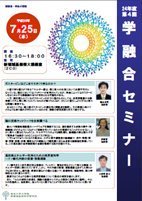AY2012 4th Gakuyugo Seminar
- Date&Time:
- Jul 25, 2012 16:30~18:00
- Venue:
- Large Lecture Room (2C0), New Frontier Science Bldg.

How small can gas turbines be made?
Associate Professor Koji OkamotoSmall, portable energy sources have already become indispensable in our daily lives. At present, batteries are widely used, but depending on the application, heat engines such as gas turbines may be more advantageous. On the other hand, among the small gas turbines currently in use, those used for emergency power supply and distributed power generation systems are among the examples, but we face various difficulties when we try to make them even smaller. In this seminar, we will explain the advantages and problems of ultra-compact gas turbines, and discuss what efforts are being made to realize them, including the latest research results.

Examinethe entire circuit network of the brain.
Associate Professor Kei Ito
To understand the hardware of the brain as an information processing device, it is essential to understand how the many elements (neurons) that make up the brain are connected to form a circuit. However, the number of brain cells in mammals such as monkeys and mice, not to mention humans, is too vast to grasp the whole picture at present. On the other hand, insects such as Drosophila use only tens of thousands of brain cells to realize a wide variety of brain functions, including control of walking, flying, searching, learning, memory, courtship, and fighting, which are as diverse as those of mammals. This paper will introduce an attempt to understand the entire neural circuitry of the insect brain.

Phase and Interface Science for High Efficiency Energy Utilization - Adsorption and Transfer Phenomena inside Nanopores
Associate Professor Hirofumi Daiguji
Porous materials with nanopores are used as adsorbents, filters, and battery materials in various environmental and energy technologies. However, the phenomena of adsorption and migration inside them are not always clear. Small differences in pore size, surface condition, etc. can significantly change the adsorption, migration, and thermodynamic properties. In this lecture, I will introduce our recent research on such various phase-interface phenomena. In this lecture, I will introduce the recent researches on such various phase interface phenomena, and discuss how the results of these researches can be effectively applied to the design of actual devices and systems to improve their performance, reduce carbon, and lower their cost.
*The contents of this page were developed based on a machine translation.

